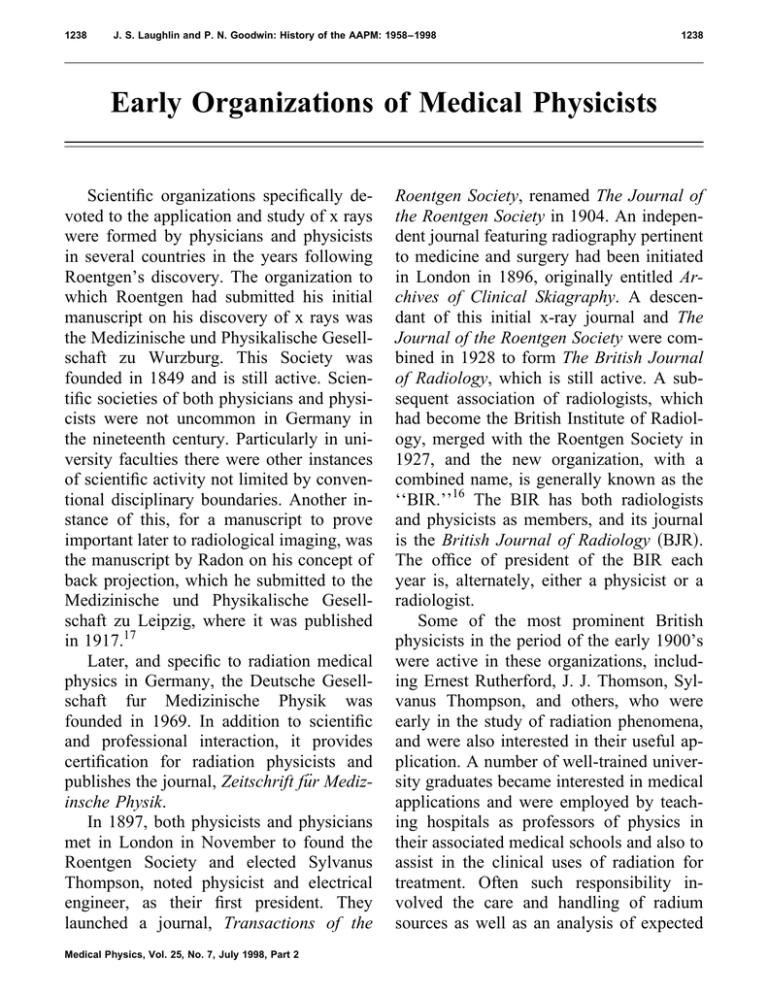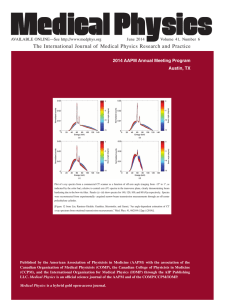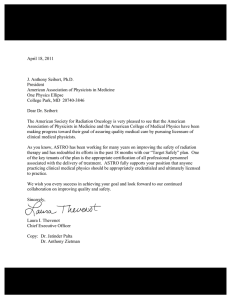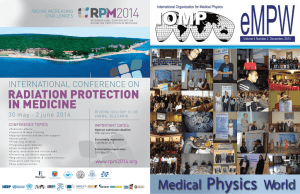Early Organizations of Medical Physicists
advertisement

1238 J. S. Laughlin and P. N. Goodwin: History of the AAPM: 1958–1998 1238 Early Organizations of Medical Physicists Scientific organizations specifically devoted to the application and study of x rays were formed by physicians and physicists in several countries in the years following Roentgen’s discovery. The organization to which Roentgen had submitted his initial manuscript on his discovery of x rays was the Medizinische und Physikalische Gesellschaft zu Wurzburg. This Society was founded in 1849 and is still active. Scientific societies of both physicians and physicists were not uncommon in Germany in the nineteenth century. Particularly in university faculties there were other instances of scientific activity not limited by conventional disciplinary boundaries. Another instance of this, for a manuscript to prove important later to radiological imaging, was the manuscript by Radon on his concept of back projection, which he submitted to the Medizinische und Physikalische Gesellschaft zu Leipzig, where it was published in 1917.17 Later, and specific to radiation medical physics in Germany, the Deutsche Gesellschaft fur Medizinische Physik was founded in 1969. In addition to scientific and professional interaction, it provides certification for radiation physicists and publishes the journal, Zeitschrift für Medizinsche Physik. In 1897, both physicists and physicians met in London in November to found the Roentgen Society and elected Sylvanus Thompson, noted physicist and electrical engineer, as their first president. They launched a journal, Transactions of the Medical Physics, Vol. 25, No. 7, July 1998, Part 2 Roentgen Society, renamed The Journal of the Roentgen Society in 1904. An independent journal featuring radiography pertinent to medicine and surgery had been initiated in London in 1896, originally entitled Archives of Clinical Skiagraphy. A descendant of this initial x-ray journal and The Journal of the Roentgen Society were combined in 1928 to form The British Journal of Radiology, which is still active. A subsequent association of radiologists, which had become the British Institute of Radiology, merged with the Roentgen Society in 1927, and the new organization, with a combined name, is generally known as the ‘‘BIR.’’16 The BIR has both radiologists and physicists as members, and its journal is the British Journal of Radiology ~BJR!. The office of president of the BIR each year is, alternately, either a physicist or a radiologist. Some of the most prominent British physicists in the period of the early 1900’s were active in these organizations, including Ernest Rutherford, J. J. Thomson, Sylvanus Thompson, and others, who were early in the study of radiation phenomena, and were also interested in their useful application. A number of well-trained university graduates became interested in medical applications and were employed by teaching hospitals as professors of physics in their associated medical schools and also to assist in the clinical uses of radiation for treatment. Often such responsibility involved the care and handling of radium sources as well as an analysis of expected 1239 J. S. Laughlin and P. N. Goodwin: History of the AAPM: 1958–1998 dose distributions using these sources, in the construction and care of radon plants, and in the planning of dose distributions obtained with orthovoltage x-ray equipment. Appointment of physicists to hospital positions in Britain commenced with the promotion of Sidney Russ at the Middlesex Hospital in London from a Fellowship position to that of physicist in 1913. This topic is clarified in a note by Alan Jennings in SCOPE.18 Russ was later advanced to an endowed chair for physics applied to medicine. At about the same time, Frank Lloyd Hopwood was serving as physicist at St. Bartholomew’s Hospital Medical School in London. William Valentine Mayneord commenced his career in hospital physics in joining Hopwood for four years. In 1927, Mayneord was appointed physicist at the Royal Cancer Hospital in London. The number of hospital physicists in Britain rose steadily. Informal meetings of hospital physicists in the London and northern England areas had occurred frequently before the World War, but essentially ceased in wartime conditions. In response to expressions of the possible need for a professional organization of hospital physicists, Sydney Russ issued invitations in 1943 to a meeting of hospital physicists to be held at the British Institute of Radiology. The sessions were convened with about 30 physicists present and resulted in a statement that: ‘‘a body should be formed to interest itself in and discuss matters arising out of the natural interests of those engaged in hospital physics’’ ~see Ref. 1!. At the time of the establishment of the Hospital Physicists’ Association ~HPA! in 1943 there were 53 Founding Members. Many of these were present at the celebraMedical Physics, Vol. 25, No. 7, July 1998, Part 2 1239 tion of the fortieth anniversary of the HPA held in Newcastle-upon-Tyne in 1983, at which time the membership was 1,401. Particularly, with the establishment of the National Health Service in 1948, considerable attention of the HPA leadership had to be devoted to the relationship of the HPA to the NHS. However, the emphasis of alternate meetings remained scientific. In 1951, George Innes initiated the HPA Bulletin, which included detailed reports of the HPA meetings and was published on a quarterly basis. It has continued to be published up to present times, now with the name Scope, under the auspices of the IPSM, IPEMB, and IPEM versions ~see below! of the membership organization. It continues to provide vital and interesting information on the activities of the membership. In 1956, the HPA initiated the scientific publication Physics in Medicine and Biology in an arrangement with Taylor and Francis ~publishers of the renowned Philosophical Magazine!. J. E. Roberts was the founding editor and served for five years, being succeeded by J. E. Rotblat. In 1960, W. K. Sinclair, with the approval of the AAPM Board, arranged with Rotblat for PMB to become the official journal of the AAPM. In 1972, the HPA arranged for the Institute of Physics to become the publisher of PMB. The PMB has steadily continued to increase its significance as a major scientific journal in the field of medical physics, not only for the HPA and for the U.K. but also internationally. In 1983 the HPA decided that the demands of professional negotiations on the time of their officers did not permit their organization to continue to handle both professional and scientific matters for the 1240 J. S. Laughlin and P. N. Goodwin: History of the AAPM: 1958–1998 membership. Accordingly, it was decided that the HPA should limit its responsibilities to professional matters, and that the scientific responsibilities should be handled by a new organization, largely for the same membership. The new organization, the Institute of Physical Sciences in Medicine ~IPSM!, handled the scientific meetings, the journals, newsletter, and scientific responsibilities generally. The same person elected to be president of the HPA served also as president of IPSM. This arrangement insured coordination of major policies of the two organizations serving different interests of the common membership. In 1995, it was decided that the professional negotiations with the National Health Service Trusts would best be carried out as member of a specific union. The HPA became the ‘‘HPA Section’’ of a union selected by them. They were also joined by the members of the Biological Engineers Society, whose members were active in hospitals. This expansion was reflected in the modified name of the scientific society which became the ‘‘Institution of Physicists and Engineers in Medicine and Biology’’ ~IPEMB!. This name has been recently ~1997! simplified to ‘‘Institute of Physicists and Engineers in Medicine’’ ~IPEM!. The earlier arrangement of a common officer ~president! was discontinued with the expansion in membership in 1995. The important objective of coordination of the two institutions serving different interests of the same membership was still realized. The president of the IPEM attends meetings of the Executive Committee of the HPA as an observer; the reciprocal arrangement allows the president of the HPA to attend the Council of the IPEM. In addition, the president of the IPEM chairs what Medical Physics, Vol. 25, No. 7, July 1998, Part 2 1240 is called the Practice Committee, which is a Joint Committee of the IPEM and the HPA, the purpose of which is to ensure that the two organizations are aware of each other’s activities and, as far as possible, that there is no conflict of interest or objective. Peter Wells and Alan Jennings have been very helpful in outlining this important development in the U.K. RADIOLOGICAL AND MEDICAL PHYSICS SOCIETY „RAMPS… During the mid 1940’s, physicists associated with medical institutions in the metropolitan New York City region commenced meetings to compare instrumentation and their measurements of the quantity of radioactivity in solutions in medical use. This was necessary for uniformity, and also for accuracy since the national standard available appeared to be inconsistent. This was just prior to the availability of megavoltage x rays and electrons, and the primary concern of the physicists was associated with the uses of radioactive nuclides. The clinical uses of iodine-131 and other radionuclides ~phosphorus-32, yttrium-90, etc.! were being actively explored and agreement on the amount of activity being administered was essential. Such measurements led to the ‘‘New York Millicurie,’’ which served a vital purpose. By 1948 the meetings of these medical physicists were on a scheduled basis with elected officers and records. Those initially active in RAMPS included Mones Berman, Hanson Blatz, Carl Braestrup, Giacchino Failla, Sergei Feitelberg, Elizabeth Focht, Hiram Hart, Lillian Jacobson, Robert Loevinger, Leo Marinelli, Eleanor Oshry, Edith Quimby, Edward Siegel, Aaron Yalow, Rosalyn Yalow, and others. This group estab- 1241 J. S. Laughlin and P. N. Goodwin: History of the AAPM: 1958–1998 lished the measurement procedure for the ‘‘New York Millicurie,’’ and their meetings served both scientific and professional functions. A constitution was written in 1954 by R. Yalow and J. Laughlin, and revised in 1957 by them. RAMPS has continued to grow from its modest beginning with a current membership of about 150, and conducts monthly meetings which are well attended. Their meetings usually include scientific presentations by a member or guest on physical aspects of treatment, diagnosis, nuclear medicine, or protection. Also, an all-day symposium on a pertinent scientific topic is held annually. RAMPS welcomed the initiation of the AAPM and became a chapter in it. Raphex. In 1968, in order to assist the training of residents in the various radiological physics specialties, RAMPS appointed a committee to prepare an examination on radiological physics. This examination was administered on a voluntary basis to radiological residents in the city at a session held at the New York Academy of Medicine with the cooperation of the New York Roentgen Ray Society. The response was so enthusiastic that this examination has become an annual event. It is now being used throughout the United States through the courtesy of RAMPS and of the AAPM. Teaching has always been an important activity of the medical physicist in his/her institution and the establishment of this examination procedure was a method of assisting the education of residents in the physical aspects of radiology. Other Chapters. As the number of medical physicists has increased, other local chapters have been formed, and most of the AAPM members are now represented by their chapter organizations. An early instance was the formation of the ‘‘RAMPS Medical Physics, Vol. 25, No. 7, July 1998, Part 2 1241 of Chicago,’’ incorporated in 1957. It is now ‘‘The Midwest Chapter of the AAPM’’ comprising five midwest states. AAPM REGIONAL CHAPTERS Connecticut ~CAMPS! Delaware Valley Florida Great Lakes Mid-Atlantic Midwest Missouri River Valley New England Southeast Southern California New Jersey New York ~RAMPS! North Central Northwest Ohio River Valley Penn–Ohio Rocky Mountain San Francisco Southwest Upstate New York A BRIEF HISTORY OF THE INTERNATIONAL ORGANIZATION FOR MEDICAL PHYSICS „IOMP… Prior to the 1960’s medical physicists had no international organization of their own. Physicists working in radiology met internationally and presented their work at the every-four-year International Congress of Radiology, but there were no regularly scheduled international meetings on medical physics. Then around 1958 the president of the British Hospital Physicists’ Association ~HPA!, Harold Miller, having corresponded with physicists in many parts of the world, suggested that there was a need for some kind of international link. Since the HPA was then the largest medical physics organization, it was agreed that they should take the lead in this endeavor. It was decided that the best time and place for an organizational meeting would be at the Ninth International Congress of Radiology to be held in Munich in July 1959. Arrangements were made through the German association, and the president of the Congress, Boris Rajewsky, invited all the 1242 J. S. Laughlin and P. N. Goodwin: History of the AAPM: 1958–1998 physicists at the Congress to attend a special meeting to be held 31 July, the day following the regular Congress sessions. Some 80 people from 20 countries attended, including about 20 medical physicists from the U.S.A. The morning session was chaired by J. W. Boag ~U.K.! and F. Wachsmann ~Germany!. A number of speakers described the status of medical physics and medical physicists in their countries. J. S. Laughlin spoke on the scope and development of medical physics in the U.S.A. The afternoon session was chaired by Sven Benner and Gail Adams. Several speakers discussed the desirability of forming a new international organization. Boag then put forward a motion to the effect that those at the meeting decide to form an international link between medical physicists in different countries, and that the corresponding committee be called ‘‘The International Committee on Medical Physics.’’ This motion was discussed and then put to a vote, and was carried unanimously. It was agreed that the HPA would initially act as a central clearing house for correspondence and information.19 The International Committee met for the first time in Stockholm in 1961, and elected a steering committee to prepare a constitution for the organization. This committee met in Montreal in 1962 and agreed to es- 1242 tablish the International Organization for Medical Physics ~IOMP! as of January 1963. The objectives of the IOMP were stated as follows: ‘‘To organize international cooperation in medical physics and allied subjects, to contribute to the advancement of medical physics in all its aspects, especially in developing countries, and to encourage and advise on the formation of national organizations of medical physics in those countries which lack such organizations.’’ At that time there were, besides the AAPM, two other American societies to which some medical physicists belonged: the Radiation Research Society ~RRS! and the Health Physics Society ~HPS!. Thus, a U.S. National Committee for Medical Physics was formed with representatives from these three societies to provide the link between the IOMP and medical physicists in the U.S. However, over the next few years the RRS and the HPS became affiliated with their respective international organizations, so that in 1974 the U.S. National Committee was dissolved, leaving the AAPM as the U.S. member of the IOMP.20 One of the accomplishments of the IOMP has been to sponsor a triennial International Conference on Medical Physics ~ICMP!. The first four were held as follows: Year Location President Secretary-General 1965 1968 1972 1976 Harrogate, England Boston, MA, U.S.A. Gothenburg, Sweden Ottawa, Canada W. V. Mayneord L. S. Taylor I. Petersen H. E. Johns George Innes E. W. Webster R. I. Magnusson Paul Pfalzner Starting in 1979 the ICMP was held jointly with the International Conference on Medical and Biological Engineering ~ICMBE!; together they were called the ‘‘World Congress on Medical Physics and Biomedical Engineering’’: Medical Physics, Vol. 25, No. 7, July 1998, Part 2 1243 J. S. Laughlin and P. N. Goodwin: History of the AAPM: 1958–1998 1243 Co-President or Co-Chairman „for the ICMP… 1979 Jerusalem, Israel 1982 Hamburg, Germany 1985 Helsinki, Finland 1988 San Antonio, Texas 1991 Kyoto, Japan 1994 Rio de Janeiro, Brazil 1997 Nice, France Future Meetings: 2000 Chicago, IL, U.S.A. 2003 Sidney, Australia At the 1979 meeting in Israel, which was held jointly with the Twelfth International Conference on Medical and Biological Engineering, sponsored by the International Federation for Medical and Biological Engineering ~IFMBE!, the leaders of the two societies agreed to form an umbrella organization. The result was the International Union on Physical and Engineering Sciences in Medicine, which in 1982 was accepted as an associate member of the International Council of Scientific Unions. E. H. Frei Dieter Harder Niilo Saranummi Gary Fullerton H. Abe C. E. de Almeida D. Geiger William Hendee The IOMP currently has affiliated organizations in some 66 countries, with more than 12,000 individual members as well as 26 corporate members. A bulletin, Medical Physics World, is published several times a year. Two sites are maintained on the World Wide Web: ‘‘Electronic Medical Physics World’’ with links to a dozen or more national societies as well as to other international organizations, and the IOMP home page at www.iomp.org. OFFICERS OF THE IOMP President 1965–69 W. V. Mayneord, U.K. 1969–72 J. S. Laughlin, U.S.A. 1972–76 R. Magnusson, Sweden 1976–79 R. Mathieu, Canada 1979–82 J. Mallard, U.K. 1982–85 A. Kaul, W. Germany 1985–88 L. H. Lanzl, U.S.A. 1988–91 J. R. Cunningham 1991–94 U. Madhvanath, India 1994–97 K. Boddy, U.K. 1997–00 C. G. Orton, U.S.A. Treasurer ~position created in 1994! 1994–00 Ann Dixon-Brown, U.K. Medical Physics, Vol. 25, No. 7, July 1998, Part 2 Vice President Secretary-General J. S. Laughlin, U.S.A. R. Magnusson, Sweden R. Mathieu, Canada J. Mallard, U.K. A. Kaul, West Germany L. H. Lanzl, U.S.A. J. R. Cunningham, Canada U. Madhvanath, India K. Boddy, U.K. C. G. Orton, U.S.A. O. Chomicki, Poland B. Waldeskog, Sweden J. R. Cameron, U.S.A. J. R. Cameron, U.S.A. R. Walstam, Sweden R. Walstam, Sweden B. Stedeford, U.K. B. Stedeford, U.K. C. G. Orton, U.S.A. C. G. Orton, U.S.A. H. Svensson, Sweden G. Fullerton, U.S.A.



